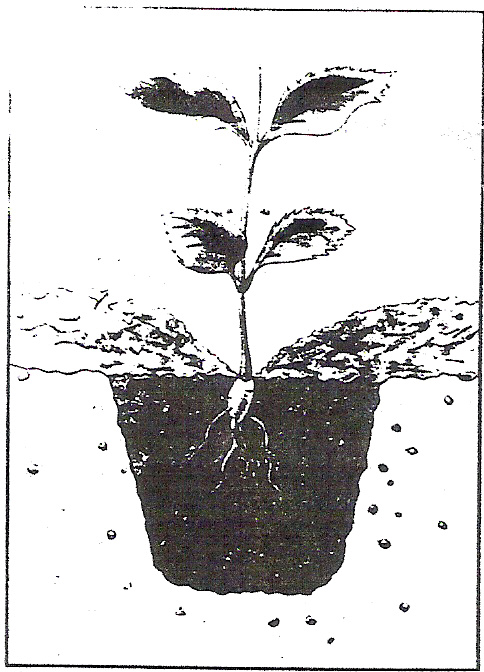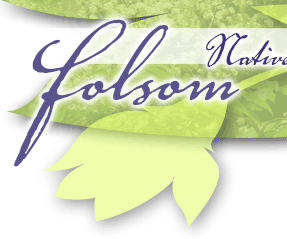|

Gardening
with Native Plants is a joy that more people should pursue.
There are many reasons why you should give native gardening a try:
- Native plants are acclimated to your climate and conditions so they
are almost care free.
- Native plants do not require commercial fertilizer or pesticides.
- Native plants provide food for wildlife and attract birds, butterflies
and other helpful insects.
- By using native plants, shrubs and trees you are doing something positive
for the environment.
- Many of the blooms on our native plants rival their imported cousins
in beauty.
We have collected various articles
that were published in the FNPS newsletter during the last 2o years that
may help you to use native plants in your gardening and landscaping endeavors.
As Henry David Thoreau wrote in his book, Wild Fruits:
Famous fruits imported from the East or South
and sold in our markets … do not concern me so much as many an unnoticed
wild berry whose beauty annually lends a new charm to some wild walk
or which I have found to be palatable to an outdoor taste. We cultivate
imported shrubs in our front yards for the beauty of their berries,
while at least equally beautiful berries grow unregarded by us in the
surrounding fields.
Native Alternatives for
Landscaping (FNPS News, Apr. & May, 2003)
Tired
of yet another Bradford Pear? Candyce writes: "Brian Tamulonis of
the Louisiana Native Plant Society suggests using the following native
flowering trees in our landscapes":
Red Buckeye,
Aesculus pavia
Serviceberry, Amelanchier arborea
Devil's Walking Stick, Aralia spinosa
Paw Paw, Asimina triloba
Redbud, Cercis canadensis
Grancy Gray Beard, Chionanthus virginicus
Parsley Hawthorne, Crataegus marshallii
Mayhaw, Crataegus opaca
Flowering Dogwood, Cornus florida
Titi, Cyrilla racemiflora
Persimmon, Diospyros virginiana
Shining Sumac, Rhus copallinum
Gordonia, Gordonia lasianthus
Two-Wing Silverbell, Halesia diptera
Dahoon Holly, flex cassine
|
American Holly,
Ilex opaca
Mountain Laurel, Kalmia tatifolia. (Rare in Louisiana,
but loves the sandy, well-drained soils found in
parts of Washington Parish.)
Bigleaf Magnolia, Magnolia macrophylla
Sweet Bay, Magnolia virginiana var. australis
Southern Crabapple, Malus angustifolia
Southern Wax Myrtle, Myrica cerifera
Devilwood, Osmanthus americanus
Ironwood, Ostrya virginiana
Sourwood, Oxydendrum arboreum
Wild Plum, Prunus americana
Black Cherry, Prunus serotina
Hop Wafer Tree, Ptelea trifoliata
Sassafras, Sassafras albidum |
| Instead
of: |
Try
These Native Alternatives: |
| English Ivy: |
Virginia Creeper, Parthenocissus
quinquefolia |
| Japanese Honeysuckle: |
Coral Honeysuckle, Lonicera
sempervirens |
| Asian Wisteria: |
Wild Wisteria, Wisteria
macrostachya |
| Asiatic
Jasmine or Fig Ivy: |
Carolina
Jessamine, Gelsemium sempervirens
Swamp Jessamine, Gelsemium rankinii
Crossvine, Bignonia capreolata |
| Tropical Passionflower: |
Maypop, Passiflora incarnata
Yellow Passionflower, Passiflora lutea (Miniature vine, good
hummingbird plant.) |
| Other Good Native
Vines: |
Leatherflower, Clematis
viorna
Swamp Leather-Flower, Clematis Crispa
Climbing Hydrangea, Decumaria barbara |
Back to Top
Helpful
Gardening Methods and Tips
BREWING A BATCH OF COMPOST TEA (FNPS News,
Nov., 1998)
Compost
tea is a liquid fertilizer made by collecting water that has been
run over compost piles or by soaking the compost. The resulting liquid
can then be applied to leaves and roots directly. Compost tea is safe
due to its organic nature and it's a great way to give plants a nutrient
boost. Compost is formed when bacteria, fungi, and other soil organisms
break down dead plant material. The resulting soil amendment is rich,
dark and crumbly. It contains water-soluble nutrients that can be leached
out.
Start by making a compost pile of faded flowers, grass clippings, manure,
leaves and other garden debris. Household vegetable waste can be added
but avoid any meat as it attracts rodents. Turn the pile with a fork to
aerate and keep it moist if possible. Once the material has broken down
to a rich humus (may take 6 months to a year), then prepare to brew.
Fill a wire sieve or plastic container with moderate holes punched out
and sink the container into a bucket of water for 7-10 days. Remove the
bucket and the resulting tea can then be applied directly to the root
zone and leaves.
Did you know... that compost tea is effective for treating early
stages of leaf spot and other fungal diseases? Remove diseased leaves
and pour tea over both sides of remaining leaves. Repeat every two weeks.
If you cannot use all the tea right away, store it covered and out of
the sun. If kept too long, the tea will ferment and begin to smell bad.
 |
|
The
Right Way to Mulch
Spread
a 2- to 4-inch layer of organic mulch on your bed, taking care to
keep it an inch or so from the crown of each plant, where the stem
and the root meet. Mulch Piled against the crown may foster rot.
|
FALL WATERING TIPS by
Linda Chance (FNPS Oct., 1997)
While Mother Nature is playing her fall drought
trick on us, it is wise to prepare ahead and be aware of climate stress
on our natives and cultivated yard plants. Here are three tips that can
make this time of year easier to manage.
#1 - Heavy mulching in summer or the beginning
of fall will benefit in preserving soil moisture and keeping roots cool.
An added bonus comes when it is allowed to remain, acting as a slow release
fertilizer through winter and early spring.
#2 - Soaker hoses will give greater returns
when used on top or under mulches for 2 to 3 hours only
once or twice weekly. Frustrations with soaring water bills and
poorly performing yard plants occur with frequent, short daily waterings
which promote shallow root systems. Leaky buckets or gallon jugs,
while not the most attractive landscape treatment, work wonders for
those hard to reach spots.
#3 - A tree or shrub whose leaves have browned and curled or
completely dropped off after 8 to 10 weeks without rain will not be
in trouble as long as the stems have not shriveled and the leaf buds are
still firm. Perennials may yellow and burn off to the ground into early
dormancy and still be fine next year if they achieved satisfactory growth
earlier in the season. Perhaps better luck with those flowers next year.
Or dried flower arrangements may be in order for this holiday season.
Back
to Top
Planting a Bog Garden
by Marion Harageones (FNPS News, June, 1998)
Do you like bog plants but don't have a boggy area in
your yard? Well, if you have a sunny location, you can make a bog. Here
is one way to do it:
1) Get a plastic container like a bucket or child's
small wading pool.
2) Dig a hole in the ground the size of the
container. Place container in hole.
3) Fill the container with the dirt from the
hole mixed with some sphagnum peat moss.
4) Plant your bog plants in the container. Fill
with water.
Another way to make a bog is to dig a hole as
wide as you like and make it about 2' deep. Line the hole with a piece
of heavy plastic then place the dirt mixed with sphagnum peat moss back
on top of the plastic. Plant your plants (being careful not to tear the
plastic) and add water. I hope you enjoy making your own personal bog
garden.
Back to Top
Native Plant Gardening
Bibliography
Bir, Richard E. Growing and Propagating Showy Native
Woody Plants. University of North Carolina Press, 1992.
Good plant descriptions with color
photographs, includes good propagation instructions and several useful
appendices.
Bryant, Geoff. Plant Propagation A to Z Growing
Plants for Free. Firefly Books, 2003.
Wonderful charts detailing hundreds
of plants and their methods of propagation
Deppe, Carol. Breed Your Own
Vegetable Varieties. Chelsea Green Publishing, 1993, 2000.
For the more advanced gardeners
who want to learn about cross pollination and other more difficult concepts.
Imes,
Rick. Wildflowers - How to Identify Flowers in the Wild and How to
Grow Them in Your Garden. Rodale Press, 1992.
Wildflower directory with color
pictures including propagation instructions. Plants are grouped according
to habitat.
Jones,
Jr., Samuel B. and Leonard E. Foote. Gardening with Native Wild Flowers.
Timber Press, 1990.
Also includes ferns, bog &
water plants, sedges and grasses.
Phillips, Harry R. Growing and
Propagating Wild Flowers. University of North Carolina Press, 1985.
Good plant descriptions with
line drawings and detailed propagations instructions including seed collection
methods.
Starting From Seed The Natural Gardeners
Guide to Propagating Plants. Brooklyn Botanic Garden, Winter
1998.
A great, little book that contains
especially good lists such as: seed sources, further reading, plant and
horticultural societies and gardening online.
Toogood, Alan, ed. American Horticultural
Society Plant Propagation. DK Publishing, Inc., 1999.
Everything you ever wanted to
know about plant propagation.
Turner, Carole B. Seed Sowing and Saving.
Storey Communications, 1998.
Appendices include: Optimal
Germination Temperatures, Characteristics of Common Vegetables from seed,
Seeds that require special treatment, Mail order Sources, Seed Exchanges
and Further Reading.
Wasowski,
Sally. Gardening with Native Plants of the South. Taylor, 1994.
Excellent plant descriptions
with limited propagation instructions
Back to Top
|



















